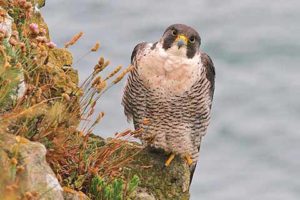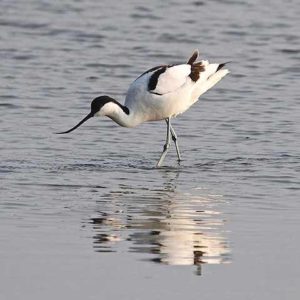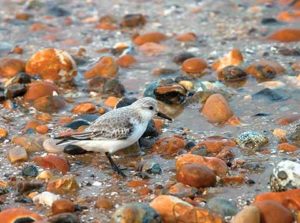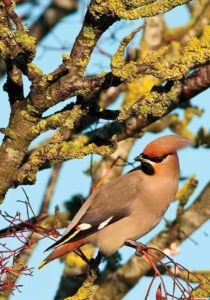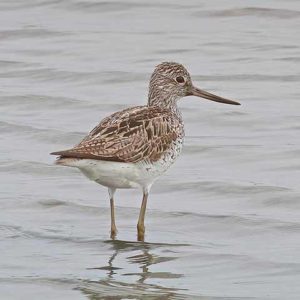Winter Migrants
Catherine Bolado looks at the birds that overwinter in Dorset
Published in January ’18
With the temperatures dropping, trees and landscapes barren and sparse and the scent of chimney smoke in the air – you might not think winter would be the best time to go looking for birds. But if you go down to the woods (or waters) today, you’re (almost) sure of a big surprise.
Dorset is a magnet for migrant and overwintering birds. Its temperate conditions, while feeling decidedly frosty to the average person, make positively balmy getaways for the many migrant species that flock to our shores each year.
The varying habitats of Purbeck and Poole Harbour are particularly good places to catch a glimpse of a rare visitor or two. The lagoon at Brownsea Island, which is owned by the National Trust and part of Dorset Wildlife Trust’s nature reserve, is a particular gem, due to its varying depth of water, range of salinity and wide range of food. At high tide in Poole Harbour, the lagoon provides a safe feeding and roosting ground, which is especially important to displaced birds including waders.
Peek out of one of the DWT hides around the lagoon between December and March, and you are likely to see spoonbill, brent geese, wigeon, red-breasted merganser, curlew, avocet, knot, black-tailed godwit, ringed plover, greenshank, spotted redshank and sanderling. Alternatively, black-necked grebe, great northern diver, goldeneye and pintail can be found in Poole Harbour itself.
Avocets, with their distinctive black and white markings, use the lagoon to overwinter in large numbers. These waders are unmistakeable as they swish their bills through the water filtering out their next meal.
If you hear a piercing ‘peep-peep’ call, then look round for oystercatchers. These striking birds use their bright orange/red bills to prise or hammer open the shells of cockles and mussels.
A top find for any budding birder has to be the spoonbill. These large white relatives of the ibis, have broad flat bills, and are almost as big as a grey heron. Another sight not to be missed is the sanderling. These sandpipers feed at the water’s edge and scamper back and forth among the waves looking for worms, insects, fish and even jellyfish. Their rather comical behaviour has earnt them the nickname ‘clockwork mice.’
One of the most exotic looking visitors to occasionally appear in Dorset is the charismatic waxwing. Rare and unpredictable, these buff coloured birds with the quiff hair-dos migrate from the northern pine forests of Russia and Scandinavia. They love to eat berries, particularly rowan and cotoneaster and often turn up in unexpected places, like housing estates (see
p41) and even supermarket car parks.
Winter is also a great time to spot Dorset’s birds of prey as they hunt across the farmland and coastal areas. Peregrine falcons, the world’s fastest birds, use their speed to swoop down on unsuspecting prey. Other birds of prey you might be lucky enough to see include the ghostly-grey hen harrier. Currently the most endangered breeding bird of prey in England, these rare raptors are sometimes seen quartering over Dorset’s winter heaths. Another rare visitor from the north is the tiny merlin, which may be glimpsed as it chases meadow pipits and other small birds.

The lagoon at Brownsea Island is a haven for native birds and migratory species alike (Credit: Stuart Canham)
The colder weather can bring many welcome visitors to our gardens. From across the North Sea, redwings and fieldfares arrive in Dorset to feast on windfall fruit and berries. Contrary to popular belief, there are still many insects around in winter, but they often go unseen as they are in their egg, larval or pupal stages. The tit family are highly adapted to find these overwintering stages, as they are highly acrobatic and light, making them able to search out these insect forms, even on the tiniest branches.
Other behavioural adaptations help smaller birds survive the colder temperatures, for example wrens are well known to congregate together in large colonies to keep warm. They often use bird boxes designed for blue tits and one box was even found to contain 50 individuals.
Like the red squirrels on Brownsea Island, jays also store food for the winter. They can often be seen hopping around in autumn, caching acorns to eat during the long winter months. That’s not to say they always remember where they stored their treasures and this behaviour has no doubt contributed to more than one Dorset oak tree.
A firm favourite amongst birders, the bearded tit can be heard ‘pinging’ in the reed beds around Poole Harbour. In summer, these striking birds, feast on aphids and then when the weather gets colder, they change their entire diet and digestive system to deal with its winter diet of reed seeds.
Blackcaps are an increasingly common visitor to gardens during the colder months, making the most of the generosity of Dorset’s bird tables. These warblers display some of the strangest behaviour of Dorset’s migrants. Many of the blackcaps that overwinter in Dorset gardens will have bred in Central Europe and then have actually flown north for the winter. Meanwhile, most of the blackcaps that bred in Dorset will have flown south to spend the winter in the Mediterranean region.
So, as you can see there’s no excuse not to head out this winter and discover some of Dorset’s wonderfully abundant and varied bird life. Across the winter, Dorset Wildlife Trust, together with the RSPB and the National Trust, will be running their popular bird watching boat tours. These trips explore Poole Harbour, with some selected cruises landing on Brownsea Island
as well.
There are a variety of dates to choose from: Harbour Cruise only (2.5 hours; £17 adult, £7.50 child) Saturday 13th January 2018, Sunday 4th February 2018 and Friday 16th February 2018. Dates for harbour cruises with Brownsea Island landing (4 hours; £22 adult, £10 child) are: Saturday 6th January 2018 and Sunday 21st January 2018. To book a place simply call
01202 707744.
Dorset Wildlife Trust is also running a winter bird cruise through Poole Harbour on Wednesday 7th March 2018 (£20 adults/£14 children). To book, phone 01305 264620.
